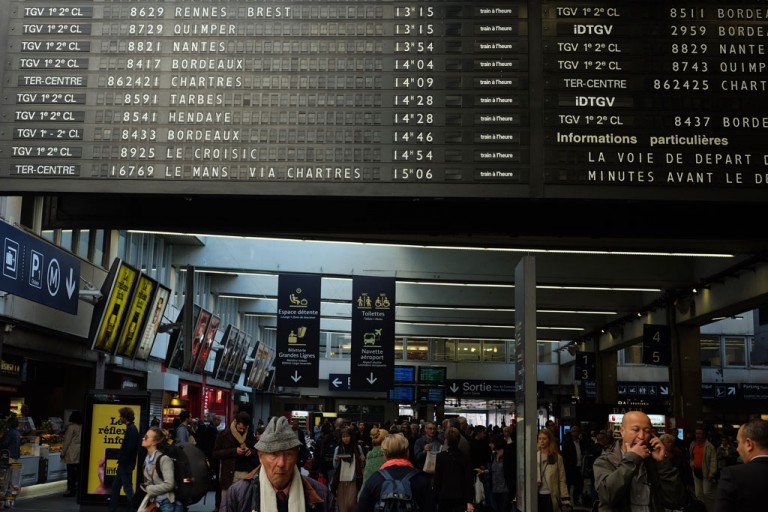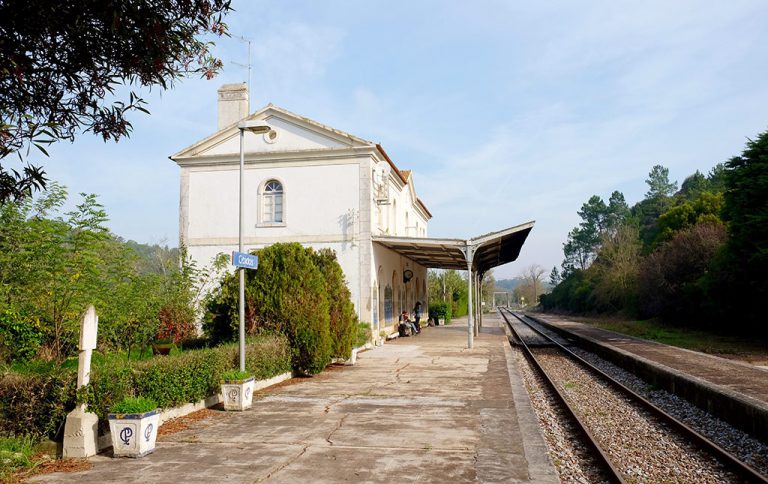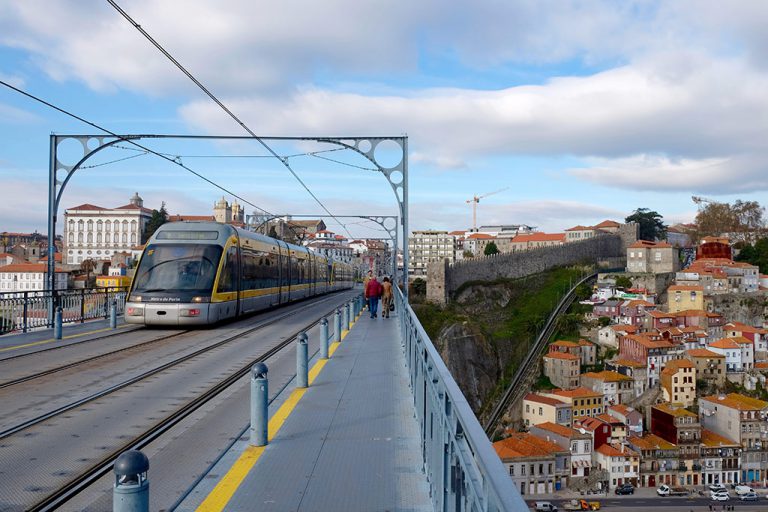
At first, the instructions on your European rail pass seem too good to be true. Validate the pass on the day of your first trip, then pen in your destination before you board the train on each subsequent journey. So easy. But then you hear about reservation fees. Some operators demand advance bookings and additional fees to secure a seat. But which ones? And how much? Is it still even worth getting a rail pass to begin with? Keep reading and you’ll soon know everything you need about rail pass reservation fees and why a rail pass is still a great option for spontaneous European travel.
Also read: How to use a rail pass to travel Europe

So you’ve got a rail pass. And now you want to follow that cute well-organised traveller you met at the hostel bar. The one who’s pre-booked their entire journey months in advance. No problem, at least as far as transport goes – just scribble in the new destination on your pass in the morning.
See an amazing view en route to Porto? Don’t think twice – just snatch your backpack off the luggage rack and hop off at the next station. Rail pass for the win.
But there’s one phrase that seems to suck all the spontaneity out of rail pass travel – the dreaded reservation fees. Some rail companies in Europe – usually fancy high-speed operators – now require you to reserve a seat, at a cost, before you actually depart on your journey. Many rail travellers avoid entire countries to skip paying the reservation fees, but I’m here to tell you that it’s not that bad, and there are ways around them.
What is a rail pass seat reservation fee?
Generally speaking, your rail pass covers all costs associated with rail travel (apart from the warm, overpriced beer in the dining cart). You pay up front for a certain number of days of rail travel over a set period, and you can go as far as you like, in any seat you like, whenever you like – whether a ticket for that leg of the trip costs €1 or €100.
But these days, in an attempt to retain as many seats as possible for full-fare paying customers, some operators charge rail pass holders a reservation fee, and then allocate you a specific seat. There may be a limited number of seats per train that rail pass users can reserve, and you may not be eligible to board the train unless you’ve paid this fee in advance.
Where and when will I pay reservation fees?
Reservation fees are only in place in certain countries and then only on specific trains and routes. There’s no fixed rule about where and when you will encounter these fees, but in general you’ll find them on the high-speed lines in France, Spain, Portugal and Italy. Almost all overnight trains in Europe also require you to reserve a seat or bed.
The Eurail app and online timetable make it very clear which trains require a reservation fee and which do not.
How to avoid paying rail pass reservation fees
It’s possible, actually quite easy, to avoid rail pass reservation fees – even if you intend travelling in countries and along routes that demand them. And I’m not talking about sitting at the back of the train and launching out of the doors as soon as the conductor appears (take it from me – the financial saving is not worth the toll it takes on your nerves).
While it’s not much of a secret anymore, if time is not of the essence, you may be able to trade the high-speed glamour of premium routes for slower regional trains – and skip the reservation fees altogether.
Most countries have multiple operators servicing a single route, and if you’re happy to make more stops, switch trains a couple of times, and take the (not always literal) scenic route to your destination, there’s a likelihood that you will be able to (legally) avoid any additional fees. In fact, the Eurail app gives you the opportunity to search the best routes between your chosen destinations that don’t charge the reservation fees.

Avoiding reservation fees can mean you’ll spend more time at isolated rural train stations such as this one in Obidos, Portugal, but it also means you able to explore some fascinating one-horse towns off the main tourist routes.
When to suck it up and pay the reservation fees
Of course, most cheapskate rail travellers like me have made the mistake of thinking they’re beating the system by taking half a dozen regional trains at snail’s pace via the middle of nowhere, only to spend double the amount they saved in reservation fees on vending machine M&Ms and stale sandwiches while waiting for the connecting train to splutter into the station.
Weigh up the pros and cons of the reservation fees carefully – sometimes it’s worth forking out the reservation fees for a high-speed train that’s going directly to your destination.
How much do reservation fees cost?
Reservation fees are not as high as you might think – though the ambiguity and elusiveness of the figures are enough to scare a lot of travellers off. Finding out the reservation fees ahead of time can be like pulling teeth, usually with the added pleasure of an impenetrable language barrier between you and the burly gentleman in the ticket booth.
In some cases, you simply need to reserve a seat ahead of time at no cost. In others, it’s usually just a few euros. In three months of travel throughout France, Spain, Portugal and Italy, the most I paid for a single reservation fee was in the region of €10. A steal, when you consider some of the routes I travelled cost other travellers in excess of €50.

Porto’s rail and tram network means getting to and around the city is a breeze, and often dramatically scenic.
Where do I pay them?
Unfortunately, most rail companies in Europe are still living in the industrial age, and the only way to reserve and pay for your seat is the old-fashioned way – in person, at the usually chaotic ticket sales windows.
Some operators and service providers are slowly emerging into the modern era and offer online seat reservations – but unless you’re reserving directly with the train company, chances are you’re paying a third-party an additional premium for this service.
Do reservation fees negate the need for a rail pass?
On previous European rail holidays I’ve actively avoided those countries that charge reservation fees. I’m cheap like that, and I was under the impression that the extra charges would cumulatively cost so much that they would negate the need for my beloved rail pass altogether.
I also thought the need to reserve a seat would be a major inconvenience and would suck all the spontaneity out of the trip. But this is not the case. The reservation fees are usually nominal, and you simply need to visit the ticket window before departure – in most cases, you can do this on the day you intend to travel. Just bear in mind that some train companies limit the number of rail pass seats on each train, so they may sell out ahead of time. The TGV in France is particularly notorious when it comes to this.
Another important factor to remember is that many high-speed rail operators in Europe have now adopted a sliding scale pricing model, much like low-cost airlines. So the closer you are to the date of departure, or the more popular a particular train journey (think national holidays, last minute trips to annual festivals, or long-distance commuter trains during rush hour), the more expensive the point-to-point ticket will be. But if you’re a pass holder, the reservation fees are usually fixed. You may have to pay a €10 reservation fee for that last minute ride from Paris to Toulouse, but the sucker next to you will have paid many times that for the same journey.
It can be a difficult task determining whether a rail pass is the best option for your holiday style, and you’ll need to consider how much the point-to-point tickets will cost in comparison, somehow factoring in the possibility of last-minute price hikes. But if you, like me, are a fan of spontaneity and frugality, don’t rule out a rail pass just because you’re venturing into reservation fee territory. It’s still likely to be the best way of seeing the best of Europe, with the least damage to your budget.
Also read: Rome to the Amalfi Coast by train
This article, Everything you need to know about European rail pass reservation fees, was originally posted on the Getaway Blog by Andrew Thompson.